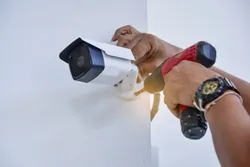HD versus IP Camera Cable Types for Security Camera Systems
CCTV is a video framework that comprises decisively positioned camcorders around an area that records film and is then communicated to a presentation monitor(s) for ongoing considering great as film playback. A CCTV framework subsequently alludes to all perspectives and parts that make up the framework, like the camera, wiring, video film capacity (employing the cloud or computerized video recorder), screens, access control, and the general framework of the board. You would need to click here to utilize a CCTV framework to expand the security of your business premises and have reconnaissance on key regions at any one time. This would be especially helpful for enormous premises or one that holds significant gear, items, or data.
As well as recording video film, a CCTV framework can likewise tell you if there is action or development on a specific camera at a set time. For example, ridiculously late while the business premises in shut and workers have returned home. This notice could show that someone may be about or expecting to break into your site. Yet a CCTV system can be used for the observation of on-the-spot activity, during and out of working hours, it can similarly be used to help with perceiving required culprits, as well as go probably as an obstruction to anticipated gatecrashers.

How Does CCTV Work?
Need to know the intricate details of how a CCTV framework functions? It’s not confounded, yet it fluctuates relying upon the kind of framework you introduce and the parts utilized. In any case, the general cycle is something similar. Comprising something like one camera, focal point, screen, and recorder, a CCTV framework can be increased or down relying upon the size of the region needing reconnaissance. CCTV works by the camera or cameras taking a consistent grouping of pictures that are then sent by link or remotely (contingent upon the picked framework type) to the recording gadget and afterward on to the presentation screen, which empowers a person to consider the succession of pictures to be video film. Contingent upon the sort of cameras utilized, they may likewise zoom in and out and turn 360 degrees.
HD Security Camera Cables
- HD surveillance cameras work over the siamese coaxial link (RG-59). This kind of link is likewise normally used to send simple signs in more established CCTV surveillance cameras as well as HD-over-cajole surveillance cameras that utilize a BNC connector. Numerous structures are now set up with siamese coaxial links, which can undoubtedly send film north of 500 feet. Not at all like IP camera link types that needn’t bother with a different power supply, HD surveillance cameras require 12 volts of DC ability to work.
- Whether you need to introduce HD-over-cajole cameras or 4-1 cameras (CVI, TVI, AHD, simple), you’ll require a link type that can send the extra data transfer capacity expected by top-quality security 720p or 1080p cameras. Beneficially, the most recent siamese links (RG-59/U) are intended to do precisely that. They’re accessible as pre-made or pre-assembled links with end connectors and differing lengths. These links are intended to interface HD cajole cameras to advanced video recorders (DVR).
IP Security Camera Cables
IP surveillance cameras work over ethernet links or PoE network links, which are the standard link type for the most recent video reconnaissance frameworks. They’re the favored choice in business-grade reconnaissance since they give both power and video signals, killing the need to have a different power hotspot for your cameras. There are various sorts accessible, including Cat5, Cat5e, and Cat6. These links interface surveillance cameras under one organization to an organization video recorder (NVR). Fewer ethernet links are expected to run a cutting-edge business-grade security framework. These links are great for more up-to-date structures or those generally moved up to the most recent CAT 5/6 link wiring. IP camera links give prevalent picture goals, from 1080p to 4K Ultra HD.

